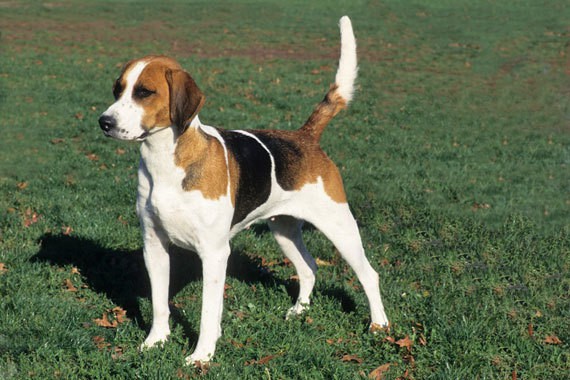Type the name of the breed you're looking for below
[wpdreams_ajaxsearchlite] Don't see the breed your're looking for? Click here and let us know!
Breed Characteristics
1 paw - breed exhibits the least amount of this characteristic
5 paws - breed exhibits most amount of this characteristic
English Foxhound
| Other Names | Foxhound |
| Country of Origin | Great Britain |
| Weight | 65 - 70 lbs. (29 - 32 kg) |
| Height (at withers) | Males: 22 - 25 in. (56 - 63 cm) Females: 21 - 24 in. (53 - 61 cm) |
| Coat | The coat is short, hard, dense and glossy. |
| Colour | Coat colours come in black, tan and white, for example tricolour (black, white and tan), or bicolour with a white background, or any combination of these three. |
| Litter Size | 5 - 7 puppies |
| Life Span | 9 - 11 years |
| Origin & History | The English Foxhound was created in the late 16th century, as a result of the perception of the depletion of deer in England. Nobles and Royalty had hunted deer for both food and sport, using the Deerhound or Staghound for this purpose. During the reign of Henry VIII, it was perceived that a new prey was needed, and the fox was selected. The English Foxhound was then created by a careful mixing of the Greyhound, for speed, the Fox Terrier, for hunting instinct, and the Bulldog, for tenacity in the hunt. During the British Raj, English Foxhounds were imported to India for the purpose of jackal coursing, though due to the comparatively hotter weather, they were rarely long lived. Foxhounds were preferred for this purpose over greyhounds, as the former was not as fast, and could thus provide a longer, more sporting chase. Studbooks for the English foxhound have been kept since the 18th century. Breeding lines and the work of people involved in breeding hounds is extremely important in the continual development of this working breed. Puppy shows are important events in the hunting calendar and allow the local hunt followers and visiting hound breeders examine the latest generation from the hound pack. The hounds were meant to trail foxes and live around horses. They are still used for those purposes. |
| Personality | The English Foxhound is a courageous, passionate hunter. High energy, it needs a lot of daily exercise. It responds well to leadership and is willing and able to be obedient, but is not as responsive as some breeds and training takes patience and a general understanding of the canine animal. They are friendly with people and excellent with children, but prefer to be in the company of other dogs and do well with other animals. The English Foxhound likes to bay. They are untiring, able to run at a consistent speed for five or six hours without stopping. Can become destructive without enough exercise. The Foxhound does slow down somewhat at about seven or eight years old. The English Foxhound is a bit stockier and slower than the American Foxhound, but has similar traits. There are two types, field lines and show lines (bench). Field types are bred for hunting and field trial work. The bench type is bred for conformation shows. Both types are energetic and need daily exercise, but field lines have a higher energy level and need even more exercise. The dominancy level in this breed varies even within the same litter. If you are not the type of person who can display a natural air of calm, but firm authority, then be sure to choose a pup that is more submissive. The temperament of both show and field lines vary widely, depending upon how the owners treat the dog and how much and what type of exercise they provide. Both types are still primarily a pack hunting dog, though they can make good companions if given sufficient exercise. It is recommended that if you are looking to own an English Foxhound solely as a pet, that you are an avid jogger, biker or hiker and are looking for a canine partner. Even show lines will need a great deal of exercise, just a little less, as field types are extremely active. This breed not only needs extensive daily exercise, but also an owner who has a determined, consistent loving approach, setting rules and structure and consistently sticking to it. |
Care Requirements
| Health | There are very few health problems in this breed. Occasionally seen are chronic hip dysplasia, renal disease, and epilepsy. |
| Grooming | The short, hard coat is easy to care for. Comb and brush with a firm bristle brush, and shampoo only when necessary. This breed is an average shedder. |
| Exercise | This breed needs extensive exercise to be happy. It needs to be taken on a daily, long, brisk walk or jog where the dog is made to walk beside or behind the human holding the lead, as in a dog’s mind, the leader leads the way and that leader needs to be the human, not the dog. Putting a backpack on the dog can help it drain its energy quicker. Jogging or biking with the dog running beside you is ideal, as these dogs can go for hours without getting tired. They are active hunting dogs that may take off after any interesting scent, so do not take the English Foxhound off its leash unless you are in a safe area. Foxhounds that are lacking in mental and/or physical exercise will become high strung and may develop destructive, behavioral issues. |
| Other Considerations | English Foxhounds are not recommended for apartment life. They are very active indoors and do best with acreage. |



